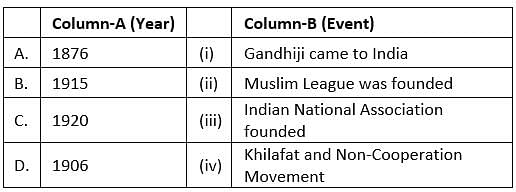Class 7 Exam > Class 7 Tests > GK Olympiad for Class 7 > Olympiad Test Level 2: India and the World- 2 - Class 7 MCQ
Olympiad Test Level 2: India and the World- 2 - Class 7 MCQ
Test Description
10 Questions MCQ Test GK Olympiad for Class 7 - Olympiad Test Level 2: India and the World- 2
Olympiad Test Level 2: India and the World- 2 for Class 7 2024 is part of GK Olympiad for Class 7 preparation. The Olympiad Test Level 2: India and the World- 2 questions and answers have been
prepared according to the Class 7 exam syllabus.The Olympiad Test Level 2: India and the World- 2 MCQs are made for Class 7 2024 Exam. Find important
definitions, questions, notes, meanings, examples, exercises, MCQs and online tests for Olympiad Test Level 2: India and the World- 2 below.
Solutions of Olympiad Test Level 2: India and the World- 2 questions in English are available as part of our GK Olympiad for Class 7 for Class 7 & Olympiad Test Level 2: India and the World- 2 solutions in
Hindi for GK Olympiad for Class 7 course. Download more important topics, notes, lectures and mock
test series for Class 7 Exam by signing up for free. Attempt Olympiad Test Level 2: India and the World- 2 | 10 questions in 20 minutes | Mock test for Class 7 preparation | Free important questions MCQ to study GK Olympiad for Class 7 for Class 7 Exam | Download free PDF with solutions
Olympiad Test Level 2: India and the World- 2 - Question 1
Match Column I with Column II and select the correct option from the given code.


Detailed Solution for Olympiad Test Level 2: India and the World- 2 - Question 2
| 1 Crore+ students have signed up on EduRev. Have you? Download the App |
Olympiad Test Level 2: India and the World- 2 - Question 3
What is the name first Roman Emperor?
Detailed Solution for Olympiad Test Level 2: India and the World- 2 - Question 3
Olympiad Test Level 2: India and the World- 2 - Question 4
Olympic games, the poems of Homer, and Hellenistic culture are associated with which civilization?
Detailed Solution for Olympiad Test Level 2: India and the World- 2 - Question 4
Olympiad Test Level 2: India and the World- 2 - Question 5
How many Tirthankaras were in Jainism?
Detailed Solution for Olympiad Test Level 2: India and the World- 2 - Question 5
Olympiad Test Level 2: India and the World- 2 - Question 6
Arrange the following freedom movements of India in the correct sequence.
Detailed Solution for Olympiad Test Level 2: India and the World- 2 - Question 6
Olympiad Test Level 2: India and the World- 2 - Question 7
Match the following Column A with column B.

Olympiad Test Level 2: India and the World- 2 - Question 8
Match the following Column A with column B.

Olympiad Test Level 2: India and the World- 2 - Question 9
General Michael O' Dwyer who was responsible for Jallianwala Bagh Massacre was shot dead by
Detailed Solution for Olympiad Test Level 2: India and the World- 2 - Question 9
Olympiad Test Level 2: India and the World- 2 - Question 10
“I, therefore, want freedom immediately, this very night, before dawn, if it can be had”. Who the great Indian leader said this line?
Detailed Solution for Olympiad Test Level 2: India and the World- 2 - Question 10
|
7 docs|68 tests
|
Information about Olympiad Test Level 2: India and the World- 2 Page
In this test you can find the Exam questions for Olympiad Test Level 2: India and the World- 2 solved & explained in the simplest way possible.
Besides giving Questions and answers for Olympiad Test Level 2: India and the World- 2, EduRev gives you an ample number of Online tests for practice

















